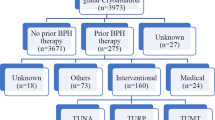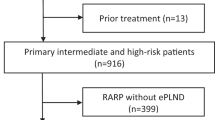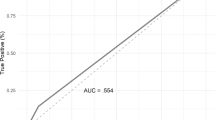Abstract
Introduction:
Cryoablation is a treatment option for prostate cancer (PCa) patients. A urethral warming catheter is placed to protect the prostatic urethra from cryo-injury. Thus tissue within certain depth beneath the urethral mucosa, including PCa in that zone, is not cryoablated. Preoperative predictors of PCa-to-urethra distance are important for urologists and patients to decide if undergoing cryoablation.
Methods:
A total of 267 consecutive radical prostatectomy specimens were reviewed by a pathologist and the shortest PCa-to-urethra distance was recorded as 0 (PCa at urethra), 0.1–1 mm, 1.1–2 mm, 2.1–3 mm, 3.1–4 mm, 4.1–5 mm and >5 mm. Preoperative serum PSA (iPSA) and prostate biopsy (Bx) parameters such as highest Bx Gleason score (BxGS), number of positive cores, highest percentage of PCa/cores, bilateral disease, perineural invasion (PNI) and PCa location were also recorded. The PCa-to-urethra distance subdivided into two (⩽3 and >3 mm) and all seven categories was correlated with iPSA and Bx parameters. Logistic and linear regression were used to analyze the data.
Results:
Patients’ median age and iPSA were 59 years and 5.28 ng ml−1, respectively. PCa-to-urethra distance was <5 mm in 163 (61%) patients, ⩽3 mm in 48% of patients. Significant univariate associations were found between shorter PCa-to-urethra distance and increasing iPSA (P<0.0001), BxGS (P=0.0016), number of positive cores (P< 0.0001), highest percentage of PCa/cores (P< 0.0001), bilateral disease (P=0.0003), PNI (P=0.01) and PCa detected in biopsies from apex (P< 0.0001), base (P=0.001) and base/medial base (P= 0.0006). In multivariate analysis, the iPSA (log), highest percentage of PCa/cores and PCa detected in the apex were significantly associated (P<0.0001) with both versions of PCa-to-urethra distance.
Conclusions:
Increasing iPSA, highest percentage of PCa/cores and PCa detected in the apex were associated with a shorter PCa-to-urethra distance. Inclusion of these preoperative parameters in a nomogram will help estimating the PCa-to-urethra distance and identifying better candidates for cryoablation.
This is a preview of subscription content, access via your institution
Access options
Subscribe to this journal
Receive 4 print issues and online access
$259.00 per year
only $64.75 per issue
Buy this article
- Purchase on Springer Link
- Instant access to full article PDF
Prices may be subject to local taxes which are calculated during checkout


Similar content being viewed by others
References
Abern MR, Tsivian M, Polascik TJ . Focal therapy of prostate cancer: evidence-based analysis for modern selection criteria. Curr Urol Rep 2012; 13: 160–169.
Nguyen CT, Jones JS . Focal therapy in the management of localized prostate cancer. BJU Int 2011; 107: 1362–1368.
Nomura T, Mimata H . Focal therapy in the management of prostate cancer: an emerging approach for localized prostate cancer. Advances in urology 2012; 2012, 3347714.
Polascik TJ, Mouraviev V . Focal therapy for prostate cancer. Curr Opin Urol 2008; 18: 269–274.
Onik G, Vaughan D, Lotenfoe R, Dineen M, Brady J . The "male lumpectomy": focal therapy for prostate cancer using cryoablation results in 48 patients with at least 2-year follow-up. Urol Oncol 2008; 26: 500–505.
Onik GM, Cohen JK, Reyes GD, Rubinsky B, Chang Z, Baust J . Transrectal ultrasound-guided percutaneous radical cryosurgical ablation of the prostate. Cancer 1993; 72: 1291–1299.
Lian H, Guo H, Gan W, Li X, Yan X, Wang W et al. Cryosurgery as primary treatment for localized prostate cancer. Int Urol Nephrol 2011; 43: 1089–1094.
Mouraviev V, Spiess PE, Jones JS . Salvage cryoablation for locally recurrent prostate cancer following primary radiotherapy. Eur Urol 2012; 61: 1204–1211.
Bahn DK, Lee F, Badalament R, Kumar A, Greski J, Chernick M . Targeted cryoablation of the prostate: 7-year outcomes in the primary treatment of prostate cancer. Urology 2002; 60: 3–11.
Cytron S, Paz A, Kravchick S, Shumalinski D, Moore J . Active rectal wall protection using direct transperineal cryo-needles for histologically proven prostate adenocarcinomas. Eur Urol 2003; 44: 315–320.
Nguyen CT, Jones JS . Focal therapy in the management of localized prostate cancer. BJU Int 2011; 107: 1362–1368.
Saliken JC, Donnelly BJ, Rewcastle JC . The evolution and state of modern technology for prostate cryosurgery. Urology 2002; 60: 26–33.
Perrotte P, Litwin MS, McGuire EJ, Scott SM, von Eschenbach AC, Pisters LL . Quality of life after salvage cryotherapy: the impact of treatment parameters. J Urol 1999; 162: 398–402.
Levy D, Avallone A, Jones JS . Current state of urological cryosurgery: prostate and kidney. BJU Int 2010; 105: 590–600.
Mouraviev V, Johansen TE, Polascik TJ . Contemporary results of focal therapy for prostate cancer using cryoablation. J Endourol 2010; 24: 827–834.
Rabin Y, Stahovich T . The thermal effect of urethral warming during cryosurgery. Cryo letters 2002; 23: 361–374.
Falzarano SM, Navas M, Simmerman K, Klein EA, Rubin MA, Zhou M et al. ERG rearrangement is present in a subset of transition zone prostatic tumors. Mod Pathol 2010; 23: 1499–1506.
Renshaw AA, Chang H, D'Amico AV . Estimation of tumor volume in radical prostatectomy specimens in routine clinical practice. Am J Clin Pathol 1997; 107: 704–708.
Jain AK, Ennis RD . Focal therapy, differential therapy, and radiation treatment for prostate cancer. Adv Urol 2012; 2012: 573193.
Borofsky MS, Ito T, Rosenkrantz AB, Taneja SS . Focal therapy for prostate cancer - where are we in 2011? Ther Adv Urol 2011; 3 4: 183–192.
Rukstalis DB, Goldknopf JL, Crowley EM, Garcia FU . Prostate cryoablation: a scientific rationale for future modifications. Urology 2002; 60: 19–25.
Baissalov R, Sandison GA, Donnelly BJ, Saliken JC, McKinnon JG, Muldrew K et al. A semi-empirical treatment planning model for optimization of multiprobe cryosurgery. Phys Med Biol 2000; 45: 1085–1098.
Larson TR, Bostwick DG, Corica A . Temperature-correlated histopathologic changes following microwave thermoablation of obstructive tissue in patients with benign prostatic hyperplasia. Urology 1996; 47: 463–469.
Leibovich BC, Blute ML, Bostwick DG, Wilson TM, Pisansky TM, Davis BJ et al. Proximity of prostate cancer to the urethra: implications for minimally invasive ablative therapies. Urology 2000; 56: 726–729.
Bostwick DG, Gould VE, Qian J, Susani M, Marberger M . Prostate cancer detected by uPM3: radical prostatectomy findings. Mod Pathol 2006; 19: 630–633.
Acknowledgements
The authors thank Brian Wells, MD, PhD, from the Quantitative Health Sciences Department at the Cleveland Clinic for his help in the development of the nomogram.
Author information
Authors and Affiliations
Corresponding author
Ethics declarations
Competing interests
J. Stephen Jones is a consultant and advisory board member for Health Tronics. Mariana M. Padilha, Karen Streator Smith, Ming Zhou, Esteban Walker and Cristina Magi-Galluzzi declare no conflicts of interest.
Rights and permissions
About this article
Cite this article
Padilha, M., Stephen Jones, J., Streator Smith, K. et al. Prediction of prostate cancer to urethra distance by a pretreatment nomogram: urethral thermoprotection implication in cryoablation. Prostate Cancer Prostatic Dis 16, 372–375 (2013). https://doi.org/10.1038/pcan.2013.32
Received:
Revised:
Accepted:
Published:
Issue Date:
DOI: https://doi.org/10.1038/pcan.2013.32
Keywords
This article is cited by
-
MRI predicts prostatic urethral involvement in men undergoing radical prostatectomy: implications for cryo-ablation of localized prostate cancer
World Journal of Urology (2021)
-
The Value and Evaluability of the PCA3 Urine Assay in Prostate Carcinoma is Independent of the Tumor Localization
Advances in Therapy (2017)



